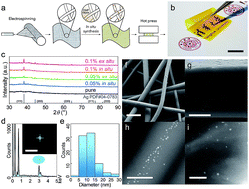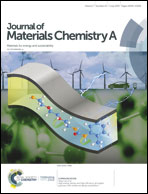Non-intuitive concomitant enhancement of dielectric permittivity, breakdown strength and energy density in percolative polymer nanocomposites by trace Ag nanodots†
Abstract
Polymer nanocomposites are considered as promising dielectric media for electrostatic capacitors which are critical energy storage devices for pulse power applications due to their ultrahigh power density, superior cycle lifetime and reliability. The maximum energy density of percolative nanocomposites filled with conductive fillers is seriously compromised by their intrinsically low breakdown strength despite their very high dielectric permittivity. Here we demonstrate that a trace amount of Ag nanodots (∼0.05 vol%) in situ synthesized in a poly(vinylidene fluoride-hexafluoropropylene) matrix gives rise to concomitant enhancement of dielectric permittivity (∼50%) and breakdown strength (∼15%) and hence ultrahigh discharge energy density (∼27 J cm−3), which is the highest energy density ever achieved for percolative polymer composites. Experimental and first principles calculation results show that the non-intuitive enhancement could be attributed to charge-transfer complexes formed between the nanodots and the polymer chains and enhanced chain mobility in an electric field.



 Please wait while we load your content...
Please wait while we load your content...